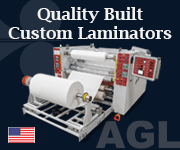Paper with a Soul: Redefining Beauty with Transformation, Not Waste
- Published: May 06, 2025
By Rob Tilsley, Fibre Operations Group Leader at James Cropper
For 180 years, we have been at the forefront of paper-based innovation. But even with that rich heritage behind us, we’re aware that we’re writing a relatively recent chapter in a story that began thousands of years ago.
Long before mills installed the first Fourdrinier papermaking machines, ancient cultures were treating pulped wood-based fibres to create a form of paper used for food wrapping. As a material, paper has a story like no other. That makes it the perfect material for us, as our ethos is to be like no other.
We’re committed to upholding paper’s legacy. But we also want to use it to make a material difference to the future, because paper has the potential to be more than just a material. It’s inseparable from the story of our planet, and in the right hands, paper has a soul. That irreplaceable soul should be at the core of the beauty industry’s approach to packaging development.
Care for Our Forests, and They’ll Care for Us
Part of this soul stems from the fact that paper isn’t just about taking from the environment. It’s equally about giving back - creating a story of renewal that rings out across the globe. That story is a powerful narrative that beauty brands can tap into.
Forests cover 31% of the world’s land area. Inside this area exist habitats for much of the world’s biodiversity, including 80% of amphibian species and 75% of bird species¹. This forestland also sequesters vast amounts of carbon emissions, including roughly a quarter of those caused by human activity².
When demand for ethically sourced paper from sustainably managed forests increases, it incentivises landowners to nurture and expand their forestland, helping to protect natural habitats and rural ecosystems. The beauty industry relies heavily on empowering messages that create a positive feeling around a purchase, and the story woven by every fibre of a paper pack absolutely supports that.
That story doesn’t end when the pack’s job is finished. Paper is the most recycled material in Europe³, which means those fibres can go back through the value chain again and again – over 25 times, if recent studies are to be believed⁴. Each secondary packaging carton can become a book, or a flyer, a moulded fibre egg carton – or another carton for a sustainably minded beauty brand.
And, just as we grow and change with each journey around the sun, so too do paper fibres. Recycled material carries with it deeply ingrained memories of its previous lives, hidden away in the delicate, microscopic peaks and troughs of its subtly textured surface. These memories can’t ever be truly understood, but they can be felt as you run your fingers over a piece of recycled board or moulded fibre. Thanks to innovations in recycled, uncoated board, it’s now possible to create options that look just like virgin board, offering the same brilliant white print surface needed to create deep, vivid colours. But consumers will still feel the many past incarnations of recycled packaging when they hold their potential purchase for the first time. This combination of premium aesthetics twinned with an authentic, naturalistic recycled texture creates a connection that money can’t buy – but which packaging can create.
Purchases with a Positive Aura
Every brand in every industry – but especially in the beauty space – should be looking to forge this kind of bond with their consumers. Beauty shoppers, in particular today’s, see the environment as a top priority, driving remarkable growth in sustainable beauty products⁵.
This becomes even more important in the age of greenwashing, which is partly responsible for consumers’ increasingly sceptical attitude towards many brands’ sustainable claims⁶. The term ‘sustainability’ is useful when describing a broad policy approach, but it does not communicate specific details – details that today’s consumers want to know. Nearly 70% of consumers research a brand’s claims before committing to a purchase⁷ – so if a supposed ‘clean label’ product is packaged in a way that undermines its overall sustainability claims, this can prove extremely costly.
In short, you can’t ‘fake it til you make it’ with today’s consumers. Often, all it takes is a single touch to make or break a sustainability narrative in a consumer’s mind. And this is where paper materials really shine.
When a consumer holds paper or moulded fibre, they’re not just holding a piece of packaging. The fibres they’re holding come from a tree that was planted in the ground decades ago. On its journey to the consumer’s hand, it could have been recycled many times, becoming anything from a coffee cup bought on a first date to a solid board pack for a child’s first Christmas present. These memories and emotions are as much a part of recycled packaging as the fibres themselves, and in the hands of a packaging craftsman, they can be used to deliver that sense of authenticity that consumers crave.
This is why we’re committed to pioneering new recycled materials through fibre-blending and upcycling technologies. These processes take fibres from a range of sources – including paper cups, offices, clothing, mills, production off-cuts and virgin fibres – and use them to produce a range of premium paper materials. And once these materials have done their job, they can go back into the recycling stream and begin their journey again. And again. And again.
Meanwhile, industry initiatives that upcycle used items like coffee cups into premium packaging are supporting this shift by boosting supplies of recycled fibre. In the past year alone, efforts like these have diverted 58 million cups from landfill, transforming them into 696 tonnes of fibre – enough to produce approximately 1,744,360 perfume boxes for top brands.
It’s why we often say you’re never far from a product made from recycled fibre. Even if the material used to produce a pack didn’t come directly from the same source, at least some of the fibres used to make it may well have done at some point in the past. The beauty of paper is that it’s never really yours – the Earth just loans it to you for a little while. One day, you’ll get to give it back. Ultimately, this is what beauty consumers want from their packaging – they want a positive experience that they can enjoy without any sense of guilt.
With all of this in mind, why would you choose just to make packaging, when you can make packaging matter? That’s the unique opportunity available to beauty brands today: to be part of something bigger – and to add your chapter into a story that never ends.
1 https://openknowledge.fao.org/handle/20.500.14283/cb9360en
2 https://news.clas.ufl.edu/climate-change-threatens-global-forest-carbon-sequestration-study-finds
3 https://twosides.info/paper-packaging-is-recycled-more-than-any-other-material
4 https://www.clustercollaboration.eu/content/new-research-paper-fibre-can-be-recycled-25-times
5 https://nielseniq.com/global/en/insights/analysis/2023/trends-in-sustainable-beauty-2023/
7 https://www.simon-kucher.com/en/insights/sustainabilitys-new-normal-what-2024-consumers-expect
ABOUT THE AUTHOR
Rob Tilsley embarked on his career at James Cropper in 2004 as a Process Operator, then transitioned into sales. Over the next 15 years, Rob held various roles, culminating in his promotion to UK Sales Manager. His exceptional performance led to his appointment as Regional Sales Manager, where he took on overall responsibility for the private label and mill collection business. He now serves as the Fibre Specialist, overseeing the use of both virgin and recovered fibers on site — a key strategic priority for the company.
Photos courtesy of James Cropper















